Wheat phenology and the drivers for yield in the high rainfall zone
Author: James Hunt (La Trobe University), Bonnie Flohr (CSIRO), Penny Riffkin (Agriculture Victoria), Richard Richards (CSIRO) and Nick Poole (FAR Australia). | Date: 23 Aug 2018
Take home messages
- Use appropriate combinations of cultivars and germination dates to ensure crops flower during the optimal period and have accumulated enough dry matter to intercept all incoming radiation by the time of flag leaf emergence.
- Cultivars with short, erect flag leaves use radiation more efficiently, and most popular currently available cultivars in the high rainfall zone (HRZ) feature this trait (Beaufort, Revenue, Trojan).
- Genetic yield potential needs to be protected with fungicides where appropriate and supported with sufficient nitrogen (N) to achieve economic yields.
Background
Wheat yields in the HRZ of south west Victoria (SW Vic) have increased markedly over the last decade. During the early 2000s, an average farm yield of 4t/ha was considered satisfactory, even though the best research plots in the same area were achieving approximately 7t/ha. Today, leading growers in the region are averaging 7t/ha across their entire farm area, with some paddocks averaging over 9t/ha. Yields in-excess of 10t/ha have been recorded in research plots. Observed yield increases are the result of the implementation of a range of management and genetic factors, including:
- Improved crop rotations controlling weeds and root disease (more canola and faba beans).
- Release of cultivars with higher genetic yield potential and better adaptation to the HRZ (Beaufort - 2008, Revenue - 2009, Trojan – 2013, Accroc - 2016).
- Earlier sowing allowing more crops to flower during the optimal period and accumulate enough dry matter to intercept all radiation during the critical period.
- Higher rates of N fertiliser.
- Increased and improved use of fungicides to control foliar diseases.
Some recent seasons have also been very favourable for high yields e.g. 2013 which featured low maximum temperatures and good rainfall during spring. This paper is going to focus on factor 2 and factor 3 – factors that result in higher yield potential in the HRZ, and how this can interact with management. As management practices (crop sequences, sowing times, nutrients, fungicides) become optimal in the HRZ, future yield gains will need to come from genetic improvements in cultivar yield potential. Unfortunately, Australian wheat breeding companies view SW Vic as a small market with low returns (poor compliance with end-point royalty payments, particularly for feed grain), meaning future yield gains will most likely come from cultivars directly imported from other countries with good adaptation to SW Vic.
What drives yield in wheat?
Wheat yield is a function of grain number (number of grains per unit area) and individual grain weight. Plant breeding has increased grain number over many years by selecting for genotypes with higher grain yield (Figure 1A, 1B). In recent decades, strong selection pressure has been applied to grain weight possibly at the cost of grain number and grain yield (Figure 1C). Of the two terms, grain number is the most important in determining yield across environments (Figure 2).
Figure 1. Grain yield increases (A) achieved through breeding from 1900-2014 as measured in cultivars popular in medium-high rainfall zone of southern New South Wales is associated with increasing grain number for the first ~80 years (B), and then increasing grain size for the last 34 years (C). Figure taken from Flohr et al. (2018). Square symbols are for 2015 (■, □) and round for 2016 (●, ○) growing seasons. Solid symbols (●, ■) are for cultivars that flower simultaneously, and hollow symbols (○, □) for cultivars sown on the same date. Deviation is the difference between the trait value for a given cultivar and the mean of each season for that trait. Bold text corresponds to flowering date balanced data, and un-bold text corresponds to sowing date balanced data. P-values and R2 are related to the regression fitted to data. Symbols (■, ●, furthest right on each of the graphs) are un-released cultivar Longsword, which has not been included in the regressions or means shown.
Figure 2. The relationship between grain number and grain yield for a common set of wheat cultivars grown in different environments across eastern Australia (Andreucci, Hunt, Huth and Hochman, unpublished data).
Grain number is primarily determined by the amount of growth (dry matter accumulation) during the later stages of spike (ear/head) development, which is the period between the emergence of the penultimate leaf (flag -1, coincides with Z33) and shortly after flowering (anthesis). This period is known as the critical period for yield determination, and grain number and thus yield is very sensitive to stress during this time (Figure 3), as any reduction in growth reduces grain number (Fischer 1985).
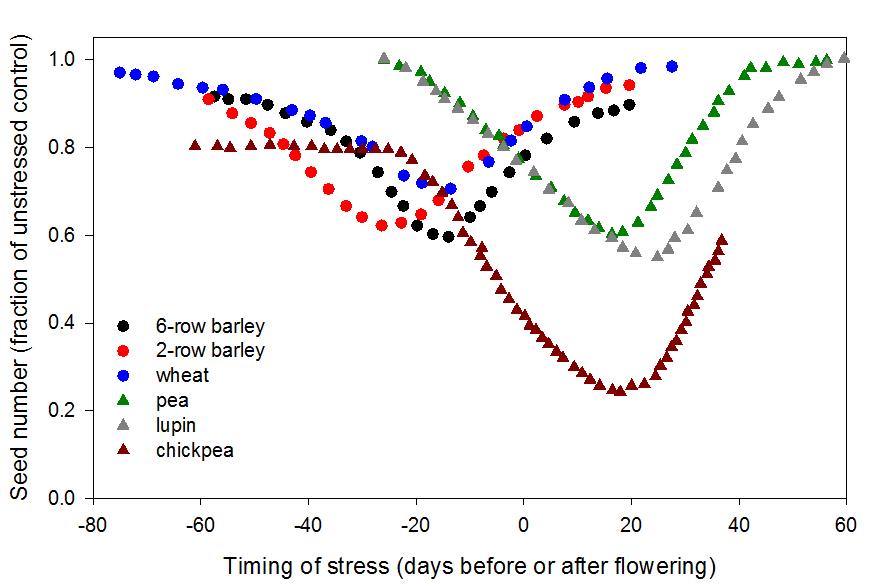
Figure 3. The timing of the critical period for seed number and thus yield determination in different grain crops (Sadras and Dreccer 2015)
Yield formation is also sensitive to the ratio of solar radiation to temperature (referred to as photothermal quotient or PTQ) experienced during the critical period. This is because radiation drives growth, and temperature drives development. Grain number is maximised when average temperatures are low (ideally approximately 14°C) and radiation is high. This is because low temperatures slow development resulting in greater dry matter accumulation, and high daily levels of solar radiation increases the rate of dry matter accumulation.
Key concept - growth versus development
Growth and development are two parameters centrally important for yield in wheat. They both respond similarly to temperature, but it is important not to confuse the two. Growth is the accumulation of dry matter by photosynthesis (minus respiration) and is a product of radiation and radiation interception by the plant. Development relates to the speed at which wheat moves through its lifecycle. The ratio of growth to development is critical in determining yield. If the plant develops too quickly, growth can be insufficient for good yields. Yields in wheat are maximised when development is slow and growth is rapid during the critical period for yield determination.
Why is phenology important for yield?
Achieving optimal flowering time
Phenology is a term that refers to the timing of the lifecycle of living things, particularly in relation to seasonal climate patterns (Figure 4). The timing of the lifecycle of wheat relative to seasonal conditions is critical to yield, and a fundamental principal of adaptation to specific environments.
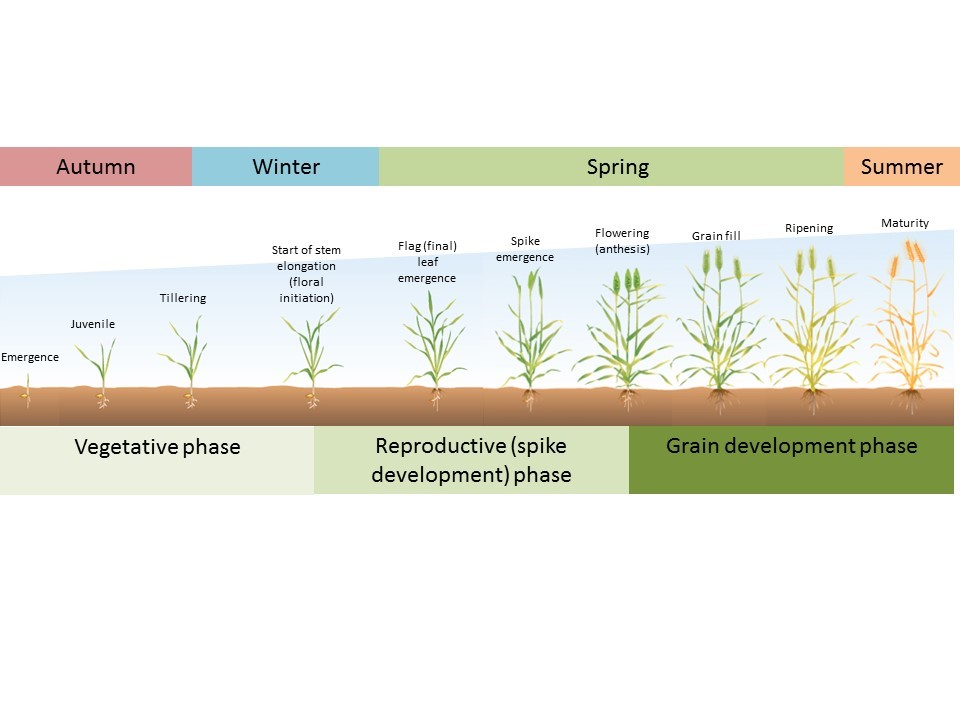
Figure 4. The life cycle of wheat showing key development stages (above images) and phases (below images) relative to seasons of the year under Australian conditions.
As described previously, wheat yield varies in its sensitivity to stress throughout its lifecycle.
Climatic conditions in an environment like SW Vic also vary seasonally and are most suitable for wheat growth from around mid-September to mid-late October i.e. during a period when solar radiation increases, mean temperature <14°C, the risk of frost and high temperatures are low and there’s a high chance of rainfall. In order to maximise yield, the timing of the critical period must coincide with this seasonal period that is most suitable for growth. Because the end of the critical period is marked by flowering, flowering is a useful point of reference when matching cultivar development to seasonal conditions. This is the concept behind the optimal flowering period (OFP). The optimal flowering period is defined as the time of year when wheat must flower in order for yields to be maximised. It is when the combined environmental determinants of yield (radiation, water availability, average temperature, extreme temperatures) are on average most favourable for grain number and thus yield. In SW Vic, the optimal flowering period is in mid-late October and can be as much as 55 days later than many of the traditional wheat growing areas such as Minnipa. (Figure 5).
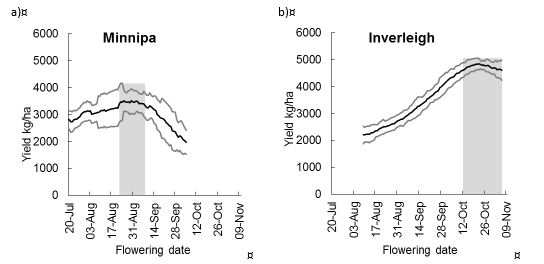
Figure 5. The relationship between spring wheat flowering time and yield in a) a traditional wheat growing area (Minnipa on the Eyre Peninsula of South Australia) and b) in the HRZ of Victoria (Inverleigh in south west Victoria). The black line is mean modelled yield from 51 years of climate data, the grey lines are positive and negative standard deviations (Flohr et al. 2017).
The timing of when a specific wheat cultivar flowers is a function of its genetic controls on development (response to thermal time, sensitivity to vernalisation and photoperiod – Refer Key concept – what drives wheat development), prevailing temperatures and germination date. In SW Vict, germination can be reliably achieved (seed bed moisture adequate but not too wet, soil temperatures below 22°C) from late April until late May. Therefore, wheat cultivars that are most suited to the environment are those that when sown during this time will flower during the optimal period. Winter wheats, such as Revenue, Manning, Adagio and Accroc, and slow spring wheats such as Beaufort and Bolac, are able to flower during the optimal period when sown in late April and early May. Whereas mid developing spring wheats such as Trojan are able to flower during the optimal period when they are sown from mid to late May.
Key concept - what drives wheat development?
The rate at which wheat develops toward flowering is driven by three factors that all act together to determine the development speed or maturity of different cultivars (Slaferet al. 2009):
- Temperature accumulation – wheat development rate is temperature dependent, it is fastest at 23°C and stops at 0°C and 37°C (Porter and Gawith 1999). Accumulation of temperature over time is measured in thermal time, the most common unit of which is day degrees (°C days). Day degrees are calculated as the sum of daily average temperature over a given period (example of calculation provided in Table 1).
Table 1. Example of calculation of thermal time over five days in two different environments.
Average daily temperature (°C)
Day 1
Day 2
Day 3
Day 4
Day 5
Thermal time (°C days)
Environment 1
20
20
20
20
20
100
Environment 2
10
10
10
10
10
50
A wheat leaf takes approximately 100 °C days to emerge, so in the example above a wheat leaf would take five days to emerge in Environment 1 and ten days to emerge in Environment 2. Wheat cultivars can vary in how many day degrees they require to reach flowering, and this is further influenced by vernalisation and photoperiod sensitivity.
- Photoperiod (day length) sensitivity – the duration of the daylight that wheat plants are exposed to can alter the speed at which they develop. Wheat is a long day plant and in photoperiod sensitive cultivars flowering is faster under long days and slower under short days. Development is most rapid at approximately 17 hours daylength and reduces linearly down to approximately eight hours, below which time development does not slow any further. This helps prevent wheat from flowering too early in winter when days are short.
- Vernalisation (cold) sensitivity – the amount of low temperatures that wheat crops are exposed to can also affect development rate. Development is accelerated in vernalisation sensitive cultivars when they are exposed to temperatures in the range of -1 to 16°C where 5°C is optimum (Porter and Gawith 1999). Vernalisation sensitive cultivars are further divided into two types:
- Winter wheats – winter wheats must experience a certain period of low temperatures (>4 weeks between -1 and 16°C) or they will not move from the vegetative to reproductive phase and will not flower. They must experience a ‘winter’ before they will flower and therefore can be sown much earlier than photoperiod sensitive wheats as they can’t be ‘tricked’ by long days and warm temperatures in autumn. The amount of vernalisation varies between cultivars from as little as four weeks for fast winter wheats such as Longsword, to eight weeks for slow winter wheats such as Manning.
- Spring wheats – most spring wheats have weak vernalisation sensitivity and while exposure to cold temperatures will speed up their development rate, they will flower eventually regardless of whether they are exposed to cold temperatures or not.
The importance of phase duration
The length of a wheat crop’s lifecycle and the length of time it spends in different developmental phases (referred to as phase duration,Figure 4) is also important in determining yield and is also determined by cultivar development rate and germination date. Longer phase durations before flowering allow crops to grow deeper root systems and access more water and nutrients. Most importantly, enough time is available during the vegetative (leaf and tiller production) and early reproductive (spike development) phases to grow enough leaf area to ensure that all incoming solar radiation is being intercepted by the start of the critical period. In SW Vic, the later that cultivars are sown the shorter their phase durations become, and if sown too late may not grow sufficient leaf area to intercept all radiation during the critical period.
However, there can be too much of a good thing. If the vegetative and reproductive periods are too long, leaf area can grow in excess of the amount required to intercept all radiation, stems become etiolated and lodging can result. These excessively large canopies can also transpire too much water prior to flowering, pushing the crop into water stress during the latter part of the critical period and grain fill, resulting in small grains, poor harvest index and yield.
Time of sowing x cultivar experiments in SW Vic indicate that phase duration is optimal in the same time of germination and cultivar combinations that achieve the optimal flowering period (e.g. Beaufort sown late April-early May, Trojan sown mid-May). There is no evidence that sowing earlier with slow developing cultivars can achieve higher grain yields and attempting to do so exposes the crops to damage from Septoria tritici (Zymoseptoria tritici).
Canopy traits important at high yields
Erect final leaves
As described previously, radiation interception during the critical period determines yield. However, cultivars vary in their ability to intercept radiation (RI) and to convert solar radiation into dry matter, which is referred to as radiation use efficiency (RUE). In environments such as SW Vic where radiation rather than water frequently limits yields, RUE is a very important trait. RUE is strongly affected by canopy architecture. Cultivars with short, erect flag leaves tend to have higher RUE. This is because this canopy structure allows light to penetrate deeper into the canopy, allowing greater surface area to intercept the same amount of solar radiation (Figure 6). This is more efficient as photosynthetic capacity becomes saturated at high levels of radiation and spreading the photons over greater area reduces the extent to which this happens. Open canopy structure also allows better airflow and penetration of fungicides into the canopy, reducing leaf area lost to foliar diseases.
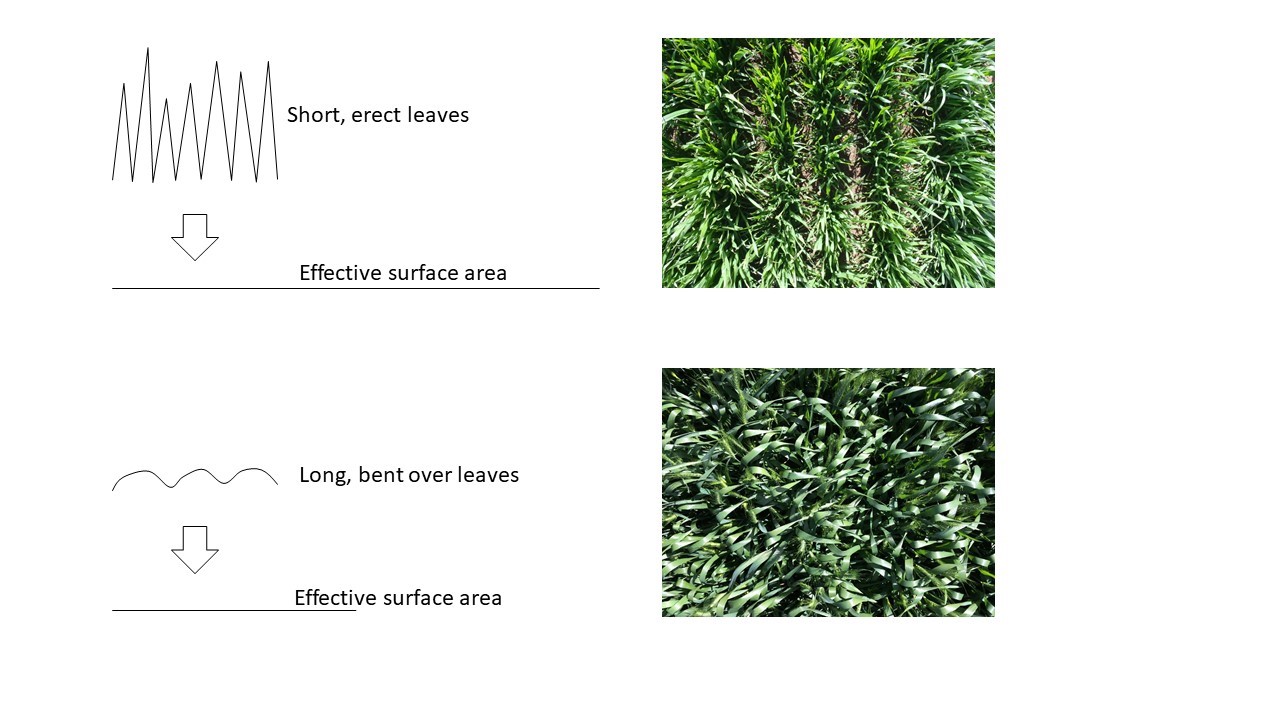
Figure 6. A schematic diagram showing the difference in effective leaf surface area in a canopy with short, erect leaves and a canopy with long leaves that have bent over.
Most cultivars currently popular in the HRZ have this trait to varying degrees e.g. Beaufort, Revenue, Trojan, Accroc. However, expression of the trait can be influenced by environment and management. Under high levels of N in the soil at sowing and low light conditions, flag leaves become longer and less erect (Figure 7).
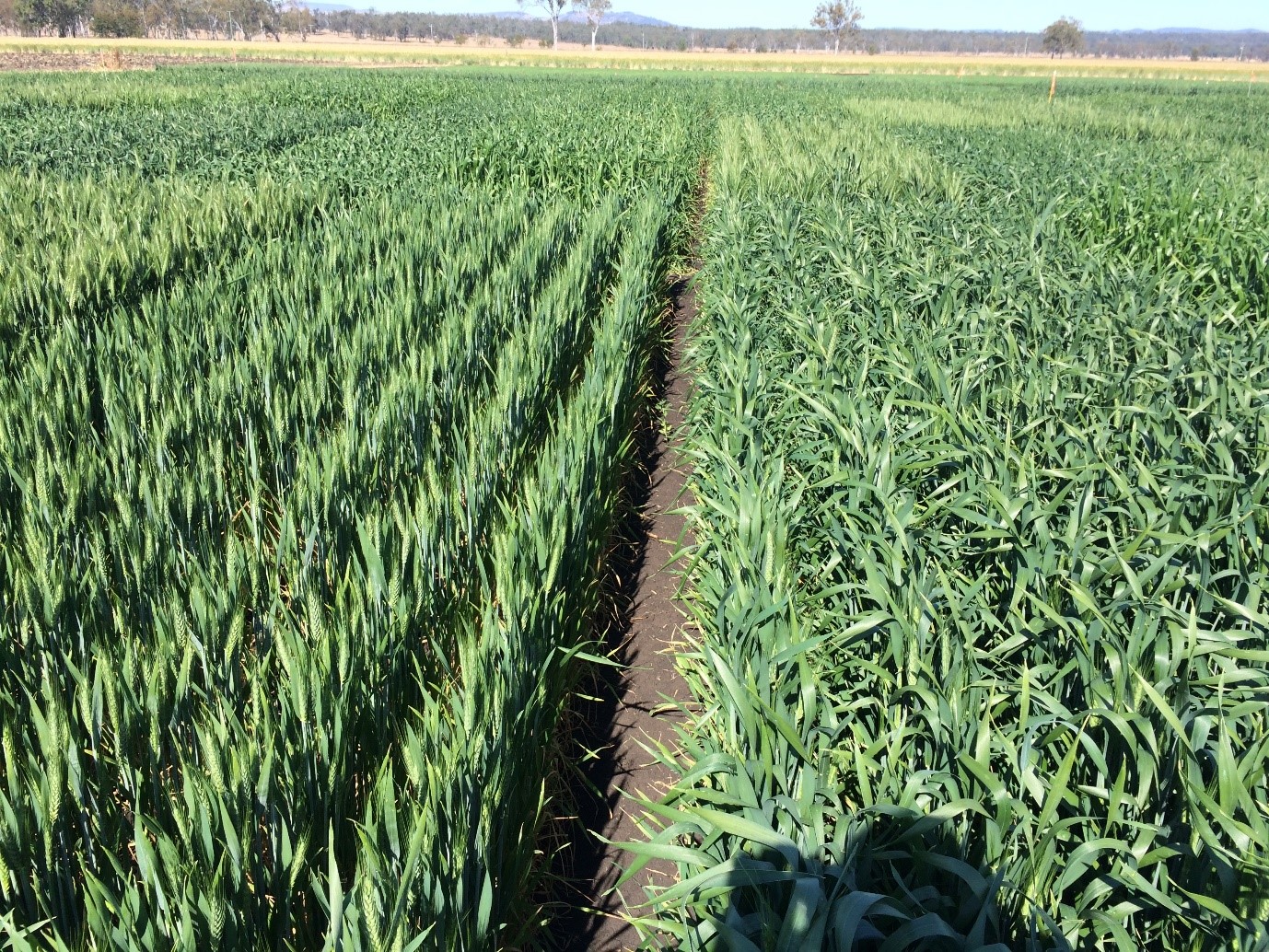
Figure 7. An example of the effect of management on leaf erectness – both plots are Trojan, the site (GRDC Irrigated Wheat trial at Gatton, QLD managed by Allan Peake, CSIRO) had very low starting soil N (50kg/ha), and the plot on the right had 210kg/ha of N applied at sowing (leaves longer and bending over), the plot on the left had the same amount applied at flag leaf emergence (leaves shorter and erect). Grain yields at harvest were identical.
Lodging resistance
The ability for crops to remain standing is absolutely vital at high grain yields. Lodging reduces yield in several ways. Firstly, it reduces RUE by reducing the surface area available for radiation interception. Secondly, it favours development of disease, and thirdly lodged crops almost always suffer more grain loss at harvest due to missed heads and rotor and sieve losses from the greater bulk of straw being put through the combine.
Lodging resistance is dependent on plant height (tall=longer lever to push plants over), ability to anchor themselves in the soil (root lodging), and the strength of their stems to withstanding bending (stem lodging). Lodging resistance is also environment and management dependent and is highly related to light interception at the start of stem elongation (Z30). Crops that are intercepting all radiation at Z30 are more likely to lodge as their stems will be overly elongated and weak and thus taller. This is even more severe in cultivars that do not have open canopies with erect leaves.
Partitioning
The efficiency at which wheat cultivars partition dry matter into grain is measured as harvest index (grain yield/total dry matter at maturity) and is also critical for yield. Cultivars with high harvest index do this by partitioning more dry matter into the developing spike during the critical period, rather than the elongating stem. This maximises spike growth during the critical period, which in turn increases grain number. Cultivars then also vary in how many grains they set per unit of spike dry weight, and this is referred to as fruiting efficiency (Slaferet al. 2015). Beaufort and Trojan are examples of cultivars that have excellent partitioning – they have very large spikes and set a large number of grains per spike. Both cultivars often set grain in additional florets compared to other cultivars.
Conclusion
Wheat yields achieved by growers in SW Vic have increased dramatically over the last decade. This has been partly due to the availability of better adapted cultivars and their interaction with improved management (crop sequence, time of sowing, N fertiliser, fungicides). For crops to achieve high yields in the HRZ, cultivars and sowing time combinations must be chosen that result in flowering occurring during the optimal period and have phase duration long enough to grow enough leaf area to intercept all solar radiation by flag-leaf emergence. Cultivars with short, erect flag leaves have higher RUE, and the highest yielding cultivars in the HRZ feature this trait. They also tend to have good lodging resistance and this needs to be supported with appropriate canopy management.
References
Fischer, RA (1985) Number of kernels in wheat crops and the influence of solar radiation and temperature. Journal of Agricultural Science 105, 447-461.
Flohr, BM, Hunt, JR, Kirkegaard, JA, Evans, JR (2017) Water and temperature stress define the optimal flowering period for wheat in south-eastern Australia. Field Crops Research 209, 108-119.
Flohr, BM, Hunt, JR, Kirkegaard, JA, Evans, JR, Swan, A, Rheinheimer, B (2018) Genetic gains in NSW wheat cultivars from 1901 to 2014 as revealed from synchronous flowering during the optimum period. European Journal of Agronomy 98, 1-13.
Porter, JR, Gawith, M (1999) Temperatures and the growth and development of wheat: a review. European Journal of Agronomy 10, 23-36.
Sadras, V, Dreccer, MF (2015) Adaptation of wheat, barley, canola, field pea and chickpea to the thermal environments of Australia. Crop and Pasture Science 66, 1137-1150.
Slafer, GA, Elia, M, Savin, R, García, GA, Terrile, II, Ferrante, A, Miralles, DJ, González, FG (2015) Fruiting efficiency: an alternative trait to further rise wheat yield. Food and Energy Security 4, 92-109.
Slafer, GA, Kantolic, AG, Appendino, ML, Miralles, DJ, Savin, R (2009) Chapter 12 - Crop Development: Genetic Control, Environmental Modulation and Relevance for Genetic Improvement of Crop Yield. In 'Crop Physiology.' (Eds VO Sadras, D Calderini.) pp. 277-308. (Academic Press: San Diego)
Acknowledgements
The research presented in this paper is made possible by the significant contributions of growers through both trial cooperation and the support of the GRDC, the author would like to thank them for their continued support.
Contact details
James Hunt
La Trobe University, AgriBio Centre for Agribiosciences, 5 Ring Rd, Bundoora 3086.
0428 636 391
j.hunt@latrobe.edu.au
@agronomeiste
GRDC Project Code: UOM1806-001RTX,
Was this page helpful?
YOUR FEEDBACK


